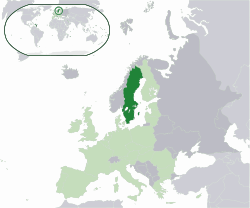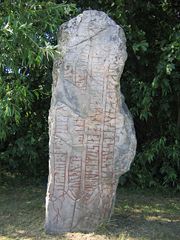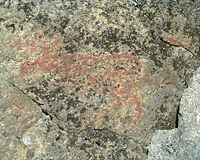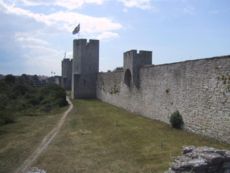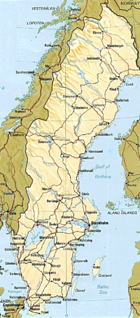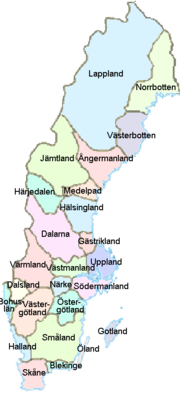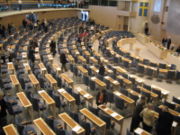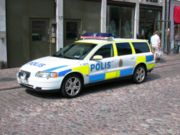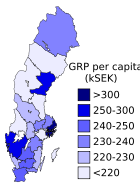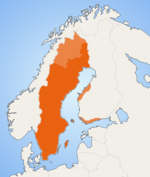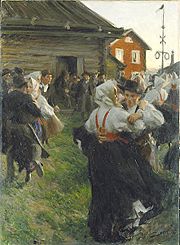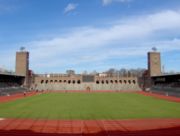Sweden
2008/9 Schools Wikipedia Selection. Related subjects: Europe; European Countries
| Konungariket Sverige Kingdom of Sweden
|
||||||
|---|---|---|---|---|---|---|
|
||||||
| Motto: (Royal) "För Sverige - I tiden" 1 "For Sweden – With the Times" |
||||||
| Anthem: Du gamla, Du fria2 Thou ancient, thou free Royal anthem: Kungssången The Song of the King |
||||||
|
Location of Sweden (dark green)
– on the European continent (light green & dark grey) |
||||||
| Capital (and largest city) |
Stockholm |
|||||
| Official languages | None3 | |||||
| Recognised regional languages | Finnish, Meänkieli, Sami, Romani, Jiddisch | |||||
| Demonym | Swedish or Swedes | |||||
| Government | Parliamentary democracy and Constitutional monarchy | |||||
| - | King | Carl XVI Gustaf | ||||
| - | Prime Minister | Fredrik Reinfeldt | ||||
| - | Speaker of the Riksdag |
Per Westerberg |
||||
| Consolidation | Prehistoric | |||||
| EU accession | 1 January 1995 | |||||
| Area | ||||||
| - | Total | 449,964 km² ( 55th) 173,732 sq mi |
||||
| - | Water (%) | 8.7 | ||||
| Population | ||||||
| - | 2008 census | 9,196,2274 | ||||
| - | Density | 20/km² ( 194th) 52/sq mi |
||||
| GDP ( PPP) | 2007 estimate | |||||
| - | Total | $333.1 billion ( 33rd) | ||||
| - | Per capita | $36,900 ( 25th) | ||||
| GDP (nominal) | 2007 estimate | |||||
| - | Total | $455 billion ( 20th) | ||||
| - | Per capita | $49,655 ( 8th) | ||||
| Gini (2005) | 23 (low) | |||||
| HDI (2004) | ▲ 0.956 (high) ( 6th) | |||||
| Currency | Swedish krona ( SEK) |
|||||
| Time zone | CET ( UTC+1) | |||||
| - | Summer ( DST) | CEST ( UTC+2) | ||||
| Internet TLD | .se5 | |||||
| Calling code | +46 | |||||
| 1 | För Sverige - I tiden has been adopted by Carl XVI Gustaf as his personal motto. | |||||
| 2 | Du gamla, Du fria has never been officially adopted as national anthem, but is so by convention. | |||||
| 3 | The Swedish language is the de facto national language, but it is not an official language in Sweden. However, the main goal of the Swedish parliament is to keep the Swedish language the main language (huvudspråk). Five other languages are officially recognized as minority languages. | |||||
| 4 | " Population in the country, counties and municipalities on 31/12/2007 and Population Change in 2007". Statistiska centralbyrån. Retrieved on 2008- 02-19. | |||||
| 5 | The .eu domain is also used, as it is shared with other European Union member states. The .nu domain is another commonly used TLD ("nu" means "now" in Swedish). | |||||
Sweden, officially the Kingdom of Sweden ( Swedish: Konungariket Sverige [ˈko:.nɵ.ŋa.ˌri:.kət ˈsvær:.jə]), is a Nordic country on the Scandinavian Peninsula in Northern Europe. Sweden has land borders with Norway and Finland, and is connected to Denmark by the Oresund Bridge. It has been a member of the European Union since January 1, 1995. Its capital city is Stockholm.
At 449.964 km² (173.732 sq mi), Sweden is the third largest country by area in Western Europe and fourth in all of Europe. With a total population slightly over 9 million, Sweden has a low population density of 20 people per km² (52 per sq. mi). About 84% of the population live in urban areas.
Modern Sweden emerged out of the Kalmar Union formed in 1397, and by the unification of the country by King Gustav Vasa in the 16th century. In the 17th century the country expanded its territories to form the Swedish empire. Most of the conquered territories outside the Scandinavian Peninsula were lost during the 18th and 19th centuries. The eastern half of Sweden constituted by the eastern half of Norrland and Österland was lost to Russia in 1809. The last war in which Sweden was directly involved was in 1814, when Sweden by military means forced Norway into a personal union with Sweden, a union which lasted until 1905. Since 1814, Sweden has been at peace, adopting a non-aligned foreign policy in peacetime and neutrality in wartime.
Etymology
The modern name Sweden is derived through "back-formation" from Old English Sweoðeod, which meant "people of the Swedes" (Old Norse Svíþjóð, Latin Suetidi). This word is derived from Sweon/Sweonas (Old Norse Sviar, Latin Suiones). The Swedish name Sverige literally means "Realm of the Swedes", excluding the Geats in Götaland.
The etymology of Swedes, and thus Sweden, is generally not agreed upon but suggestively deriving from Proto-Germanic *Swihoniz meaning "one's own", referring to one's own Germanic tribe.
History
Prehistory
Sweden's prehistory begins in the Allerød warm period c. 12,000 BC with Late Palaeolithic reindeer-hunting camps of the Bromme culture at the edge of the ice in what is now the country's southernmost province. This period was characterized by small bands of hunter-gatherer-fishers using flint technology.
Farming and animal husbandry, along with monumental burial, polished flint axes and decorated pottery, arrived from the Continent with the Funnel-beaker Culture in c. 4,000 BC. Sweden's southern third was part of the stock-keeping and agricultural Nordic Bronze Age Culture's area, most of it being peripheral to the culture's Danish centre. The period began in c. 1700 with the start of bronze imports from Europe. Copper mining was never tried locally during this period, and Scandinavia has no tin deposits, so all metal had to be imported though it was largely cast into local designs on arrival.
The Nordic Bronze Age was entirely pre-urban, with people living in hamlets and on farmsteads with single-story wooden long-houses.
In the absence of any Roman occupation, Sweden's Iron Age is reckoned up to the introduction of stone architecture and monastic orders about 1100 AD. Much of the period is proto-historical, that is, there are written sources but most hold a very low source-critical quality. The scraps of written matter are either much later than the period in question, written in areas far away, or local and coeval but extremely brief.
The climate took a turn for the worse, forcing farmers to keep cattle indoors over the winters, leading to an annual build-up of manure that could now for the first time be used systematically for soil improvement.
A Roman attempt to move the Imperial border forward from the Rhine to the Elbe was aborted in AD 9 when Germans under Roman-trained leadership defeated the legions of Varus by ambush in the Battle of the Teutoburg Forest. About this time, a major shift in the material culture of Scandinavia occurred, reflecting increased contact with the Romans.
Starting in the 2nd century AD, much of southern Sweden's agricultural land was parcelled up with low stone walls. They divided the land into permanent infields and meadows for winter fodder on one side of the wall, and wooded outland where the cattle was grazed on the other side. This principle of landscape organization survived into the 19th century. The Roman Period also saw the first large-scale expansion of agricultural settlement up the Baltic coast of the country's northern two thirds.
Sweden enters proto-history with the Germania of Tacitus in 98 AD. Whether any of the brief information he reports about this distant barbaric area was well-founded is uncertain, but he does mention tribal names that correspond to the Swedes ( Suiones) and the Sami ( Fenni) of later centuries. As for literacy in Sweden itself, the runic script was invented among the south Scandinavian elite in the 2nd century, but all that has come down to the present from the Roman Period is curt inscriptions on artefacts, mainly of male names, demonstrating that the people of south Scandinavia spoke Proto-Norse at the time, a language ancestral to Swedish and other North Germanic languages.
Viking and Middle ages
The Swedish Viking Age lasted roughly between the eighth and eleventh centuries AD. During this period, it is believed that the Swedes expanded from eastern Sweden and incorporated the Geats to the south. While Vikings from what is today Norway, Denmark and the west coast and south of Sweden travelled south and west, Swedish vikings and Gutar travelled east and south, going to Finland, the Baltic countries, Russia, the Mediterranean and further as far as Baghdad. Their routes passed the rivers of Russia down south to Constantinople (Byzantine Empire) (present-day Istanbul, Turkey) on which they did numerous raids. The Byzantine Emperor Theophilos noticed their great skills in war, and invited them to serve as his personal bodyguard, these were called the varangian guard. The Swedish vikings Template:Early Swedish history. The Swedish vikings ( Rus) are, according to the most popular theory, believed to have to have founded Russia. The adventures of these Swedish Vikings are commemorated on many runestones in Sweden, such as the Greece Runestones and the Varangian Runestones. There was also considerable participation in expeditions westwards, which are commorated on stones such as the England Runestones. The last major Swedish Viking expedition appears to have been the ill-fated expedition of Ingvar the Far-Travelled to Serkland, the region south-east of the Caspian Sea. Its members are commemorated on the Ingvar Runestones, none of which mentions any survivor. What happened to the crew is unknown, but it is believed that they died of sickness.
It is not known when and how the kingdom of Sweden was born, but the list of Swedish monarchs is drawn from the first kings who ruled Svealand (Sweden) and Götaland (Gothia) as one with Erik the Victorious. Sweden and Gothia were two separate nations long before that. It is not known how long they existed, Beowulf described semi-legendary Swedish-Geatish wars in the sixth century AD.
During the early stages of the Scandinavian Viking Age, Ystad in Scania and Paviken on Gotland, in present-day Sweden, were flourishing trade centers. Remains of what is believed to have been a large market have been found in Ystad dating from 600–700 AD. In Paviken, an important centre of trade in the Baltic region during the ninth and tenth century, remains have been found of a large Viking Age harbour with shipbuilding yards and handicraft industries. Between 800 and 1000, trade brought an abundance of silver to Gotland and according to some scholars, the Gotlanders of this era hoarded more silver than the rest of the population of Scandinavia combined.
St. Ansgar introduced Christianity around 829, but the new religion did not begin to fully replace paganism until the twelfth century and onward. During the 11th century, Christianity became the most prevalent religion, and from the year 1050 Sweden is counted as a Christian nation. The period between 1100 and 1400 was characterized by internal power struggles and competition among the Nordic kingdoms, including struggles for territory and comparative power. Swedish kings also began to expand the Swedish-controlled territory in Finland, creating conflicts with the Rus.
In the 14th century, Sweden was struck by the Black Death (the Plague). During this period the Swedish cities also began to acquire greater rights and were strongly influenced by German merchants of the Hanseatic League, active especially at Visby. In 1319, Sweden and Norway were united under King Magnus Eriksson and in 1397 Queen Margaret I of Denmark effected the personal union of Sweden, Norway, and Denmark through the Kalmar Union. However, Margaret’s successors, whose rule was also centred in Denmark, were unable to control the Swedish nobility. Real power was held for long periods by regents (notably those of the Sture family) chosen by the Swedish parliament. King Christian II of Denmark, who asserted his claim to Sweden by force of arms, ordered a massacre in 1520 of Swedish nobles at Stockholm. This came to be known as the “ Stockholm blood bath” and stirred the Swedish nobility to new resistance and, on 6 June (now Sweden's national holiday) in 1523, they made Gustav Vasa their king. This is sometimes considered as the foundation of modern Sweden. Shortly afterwards he rejected Catholicism and led Sweden into the Protestant Reformation. Gustav Vasa is considered to be Sweden's " Father of the Nation".
Swedish Empire

Sweden proper Kexholm County Swedish Ingria Swedish Estonia Livonia Swedish Pomerania, Abp Bremen and Bp Verden Scania, Blekinge, Halland, Gotland and Bohuslän Trøndelag and Møre og Romsdal Jämtland, Härjedalen, Idre & Särna
The 17th century saw the rise of Sweden as one of the Great Powers in Europe. Sweden also had colonial possessions as a minor colonial Empire that existed from 1638—1663 and later 1785—1878.
Sweden was during Imperial times the most powerful country of northern Europe and the Baltic Sea. Sweden's Imperial status took its start with Gustav II Adolph as king, who made Sweden the third biggest nation in Europe by area after Russia and Spain, and his successful participation in the Thirty Years' War, which made Sweden the recognized leader of continental Protestantism in Europe until 1721, when the Empire collapsed. Sweden's Imperial status during this period is largely credited to Gustav I's major changes on the Swedish economy in the mid-1500s, and his introduction of Protestantism (Lutheran).
The mid 1600s and the early 1700s were Sweden's most successful years as a great power. Sweden reached its largest territorial extent as an empire during the rule of Charles X (1622–1660) after the treaty of Roskilde in 1658. However, Sweden's largest territorial extent lasted from 1319 to 1343 with Magnus Eriksson ruling all of the traditional lands of Sweden and Norway. 17th century saw Sweden engaged in warfare with the Polish-Lithuanian Commonwealth with both sides competing for territories of today's Baltic states, with the disastrous Battle of Kircholm being one of the highlights. This period also saw the Deluge - the Swedish invasion of the Polish-Lithuanian Commonwealth. After more than a half century of almost constant warfare the Swedish economy had deteriorated. It would become the lifetime task of Charles' son, Charles XI (1655-1697), to rebuild the economy and refit the army. His legacy to his son, the coming ruler of Sweden Charles XII, was one of the finest arsenals in the world, a large standing army and a great fleet. Sweden's largest threat at this time, Russia, had a larger army but was far behind in both equipment and training. After the Battle of Narva in 1700, one of the first battles of the Great Northern War, the Russian army was so severely injured, that Sweden had an open chance to invade Russia. Instead, however, Charles XII invaded Poland and changed their king to a more Swedish friendly one. However after the crushing defeat at poltava the old king quickly took his throne back. This gave the Russian Tsar time to rebuild and modernize his army. After the success of invading Poland Charles decided to make an invasion attempt of Russia, which however, ended in a decisive Russian victory at the Battle of Poltava in 1709. The campaign had a successful opening for Sweden, which came to occupy Poland and change their rule into a more Swedish friendly king. But after a long march exposed by cossack raids, the Russian Tsar Peter the Great's scorched-earth techniques and the cold Russian climate, the Swedes stood weakened with a shattered confidence, and enormously outnumbered against the Russian army at Poltava. The defeat meant the beginning of the end for Sweden as Empire.
After building up a new army Charles XII attempted to invade Norway 1716, however he was shot at Fredriksten fortress in 1718. The Swedish military was not defeated at Fredriksten. However, when Karl died the whole structure and organisation of the Norwegian campaign fell apart and the army withdrew back home. However this led to defeat, the Swedish head of state signed the Treaty of Nystad in 1721. Forced to cede large areas of land, Sweden also lost its place as an empire and as the dominant state on the Baltic Sea. With Sweden's lost influence, Russia began to emerge as an empire, and become one of Europe's dominant nations.
In the 18th century, Sweden did not have enough resources to maintain its territories outside Scandinavia and most of them were lost, culminating with the 1809 loss of the eastern part to Russia: forming the semi-autonomous ( Duchy) of Finland of Imperial Russia.
After Denmark-Norway was defeated in the Napoleonic Wars, Norway was ceded to the king of Sweden on 14 January 1814, at the Treaty of Kiel. The Norwegian attempts to keep their status as a sovereign state were rejected by the Swedish king, Charles XIII. He launched a military campaign against Norway on July 27, 1814, ending in the Convention of Moss, which forced Norway into a personal union with Sweden, which was not dissolved until 1905. The 1814 campaign was also the last war in which Sweden participated as a combatant.
Modern history
The 18th and 19th centuries saw a significant population increase, which the writer Esaias Tegnér in 1833 famously attributed to "the peace, the (smallpox) vaccine, and the potatoes". Between 1750 and 1850, the population in Sweden doubled. According to some scholars, mass emigration to America became the only way to prevent famine and rebellion; over 1 percent of the population emigrated annually during the 1880s. Nevertheless, Sweden remained poor, retaining a nearly entirely agricultural economy even as Denmark and Western European countries began to industrialize. Many looked towards America for a better life during this time. It is believed that between 1850 and 1910 more than one million Swedes moved to the United States. In the early 20th century, more Swedes lived in Chicago than in Gothenburg (Sweden's second largest city). Most Swedish immigrants moved to the Midwestern United States, with a large population in Minnesota. Some Swedes moved to Delaware. Some also moved to Canada and others in smaller numbers to Argentina.
Despite the slow rate of industrialization into the 19th century, many important changes were taking place in the agrarian economy due to innovations and the large population growth. These innovations included government-sponsored programs of enclosure, aggressive exploitation of agricultural lands, and the introduction of new crops such as the potato. Due also to the fact that the Swedish peasantry had never been enserfed as elsewhere in Europe, the Swedish farming culture began to take on a critical role in the Swedish political process, which has continued through modern times with modern Agrarian party (now called the Centre Party). Between 1870 and 1914, Sweden began developing the industrialized economy that exists today.
Strong grassroots movements sprung up in Sweden during the latter half of the nineteenth century (trade unions, temperance groups, and independent religious groups), creating a strong foundation of democratic principles. These movements precipitated Sweden's migration into a modern parliamentary democracy, achieved by the time of World War I. As the Industrial Revolution progressed during the twentieth century, people gradually began moving into cities to work in factories, and became involved in socialist unions. A socialist revolution was avoided in 1917, following the re-introduction of parliamentarism, and the country was democratized.
World Wars
Sweden remained officially neutral during World War I and World War II, although its neutrality during World War II has been vigorously debated. Sweden was under German influence for most of the war, as ties to the rest of the world were cut off through blockades. The Swedish government felt that it was in no position to openly contest Germany, and therefore collaborated with Hitler. Swedish volunteers in Nazi SS units were among the first to invade the Soviet Union in Operation Barbarossa. Sweden also supplied steel and machined parts to Germany throughout the war. Toward the end of the war however, when the defeat of Germany seemed imminent, Sweden began to play a role in humanitarian efforts and many refugees, among them many Jews from Nazi-occupied Europe, were saved partly because of the Swedish involvement in rescue missions at the internment camps and partly because Sweden served as a haven for refugees, primarily from Norden and the Baltic states. Nevertheless, internal and external critics have argued that Sweden could have done more to resist the Nazi war effort, even if risking occupation.
Cold War
Following the war, Sweden took advantage of an intact industrial base, social stability and its natural resources to expand its industry to supply the rebuilding of Europe. By the 1960s, Sweden, like the other Nordic countries, had become an affluent consumer society and welfare state. Sweden was part of the Marshall Plan and participated in the Organisation of Economic Co-operation and Development ( OECD), many of the policies aiming to improve the quality of life for the general population, in particular Sweden's working class, were successfully implemented.
Sweden, like countries around the globe, entered a period of economic decline and upheaval, following the oil embargoes of 1973-74 and 1978-79. In the 1980s pillars of Swedish industry were massively restructured. Shipbuilding was discontinued, wood pulp was integrated into modernized paper production, the steel industry was concentrated and specialized, and mechanical engineering was roboticized. Prime Minister Olof Palme was murdered in 1986.
Between 1970 and 1990 Sweden increased overall tax burden by over ten percentage points and the growth was very low compared to most other countries in Western Europe. Sweden steadily lost its top5 position in rankings such as GDP per capita, but still remains in top. Due to the generous allowances Sweden is ranked very high in matter of health rankings.
Recent history
A bursting real estate bubble caused by inadequate controls on lending combined with an international recession and a policy switch from anti-unemployment policies to anti-inflationary policies resulted in a fiscal crisis in the early 1990s. Sweden's GDP declined by around 5%. In 1992 there was a run on the currency, the central bank briefly jacking up interest to 500% in an unsuccessful effort to defend the currency's fixed exchange rate. Total employment fell by almost 10% during the crisis.
The response of the government was to cut spending and institute a multitude of reforms to improve Sweden's competitiveness, among them reducing the welfare state and privatizing public services and goods. Much of the political establishment promoted EU membership, and the Swedish referendum passed by 52-48% in favour of joining the EU on 14 August 1994.
Sweden joined the European Union on 1 January 1995, after the collapse of the Soviet Union. During the Cold War, Europe's non-aligned Western countries, except Ireland, had considered membership unwise, as the EU predecessor, the European Community, had been strongly associated with NATO countries. Following the end of the Cold War, however, Sweden, Austria and Finland joined, though in Sweden's case without adopting the Euro. Sweden remains non-aligned militarily, although it participates in some joint military exercises with NATO and some other countries, in addition to extensive cooperation with other European countries in the area of defence technology and defence industry. Among others, Swedish companies export weapons that are used by the American military in Iraq. Sweden also has a long history of participating in international military operations, including most recently, Afghanistan, where Swedish troops are under NATO command, and in EU sponsored peacekeeping operations in UN protectorate Kosovo, Bosnia and Herzegovina, and Cyprus. Foreign minister Anna Lindh was murdered in 2003.
Geography and climate

Situated in Northern Europe, Sweden lies west of the Baltic Sea and Gulf of Bothnia, providing a long coastline, and forms the eastern part of the Scandinavian Peninsula. To the west is the Scandinavian mountain chain (Skanderna), a range that separates Sweden from Norway.
Sweden is surrounded by Norway (west), Finland (northeast), the Skagerrak, Kattegat and Öresund straits (southwest) and the Baltic Sea (east). It has maritime borders with Denmark, Germany, Poland, Russia, Lithuania, Latvia, and Estonia, and it is also linked to Denmark (southwest) by the Öresund Bridge.
At 449,964 km² (173,732 sq mi), Sweden is the 55th largest country in the world. It is the 5th largest in Europe, and the largest in Northern Europe. The country is slightly larger than the U.S. state of California, with a population in 2006 of 9.1 million people.
The lowest elevation in Sweden is in the bay of Lake Hammarsjön, near Kristianstad at -2.41 m (−7.91 ft) below sea level. The highest point is Kebnekaise at 2,111 m (6,926 ft) above sea level.
Sweden has 25 provinces or landskap (landscapes), based on culture, geography and history; Bohuslän, Blekinge, Dalarna, Dalsland, Gotland, Gästrikland, Halland, Hälsingland, Härjedalen, Jämtland, Lapland, Medelpad, Norrbotten, Närke, Skåne, Småland, Södermanland, Uppland, Värmland, Västmanland, Västerbotten, Västergötland, Ångermanland, Öland and Östergötland. While these provinces serve no political or administrative purpose, they are common in everyday language. The provinces are usually grouped together in three large lands, parts, Norrland, Svealand and Götaland.
About 15% of Sweden lies north of the Arctic Circle. Southern Sweden is predominantly agricultural, with increasing forest coverage northward. The highest population density is in the Öresund region in southern Sweden, and in the valley of lake Mälaren in central Sweden. Gotland and Öland are Sweden's largest islands; Vänern and Vättern are Sweden's largest lakes.
Climate
Sweden has a mild temperate climate despite its northern latitude, mainly because of the Gulf Stream. In the mountains of northern Sweden a sub-Arctic climate predominates. North of the Arctic Circle, the sun never sets for part of each summer, and in the winter, night is similarly unending.
In southern and central Sweden, summers are warm with cool evening; while in north, it's cooler. Heatwaves and temperatures around 25 - 30°C often occur during the summer, even in north. During winter, temperatures are around freezing point in south, sligtly below freezing in central and very cold, snowy and below freezing for around 6 months in north.
Yearly average precipitation in most of the country is between 500 and 800 millimeter per year. In some parts though the average is between 1000 and 1700 mm/year. Thunderstorms could occur during the summer. Snowfall usally occur from novemeber to april, although longer in north.
| Average high and low temperatures in various cities in Sweden - north to south - (°C) | |||||||||||||||||||||||||
| City | Jan | Feb | Mar | Apr | May | Jun | Jul | Aug | Sep | Oct | Nov | Dec | |||||||||||||
|---|---|---|---|---|---|---|---|---|---|---|---|---|---|---|---|---|---|---|---|---|---|---|---|---|---|
| Kiruna | -10/-19 | -8/-18 | -4/-14 | 1/-8 | 7/-1 | 14/5 | 17/7 | 14/6 | 8/1 | 2/-5 | -5/-12 | -8/-17 | |||||||||||||
| Östersund | -6/-12 | -4/-11 | -2/-7 | 4/-3 | 12/3 | 17/7 | 18/9 | 16/8 | 11/5 | 6/1 | 2/-5 | -3/-9 | |||||||||||||
| Stockholm | -1/-5 | -1/-5 | 3/-3 | 8/1 | 16/6 | 21/11 | 22/13 | 20/12 | 15/9 | 9/5 | 4/1 | 1/-3 | |||||||||||||
| Gothenburg | 1/-3 | 2/-4 | 5/-1 | 9/2 | 16/7 | 19/11 | 20/13 | 20/12 | 16/9 | 11/6 | 6/2 | 3/-2 | |||||||||||||
| Visby | 1/-3 | 1/-3 | 3/-2 | 7/1 | 14/6 | 18/11 | 20/13 | 19/13 | 15/10 | 11/6 | 6/2 | 3/-1 | |||||||||||||
| Malmö | 3/-1 | 2/-2 | 5/0 | 9/2 | 16/7 | 19/11 | 21/13 | 21/12 | 16/10 | 12/7 | 7/3 | 4/2 | Weather.com | ||||||||||||
Administration and politics
Sweden is a mixture of constitutional monarchy, in which King Carl XVI Gustaf is head of state, but royal power has long been limited to official and ceremonial functions. The Economist Intelligence Unit, while admitting that democracy is difficult to measure, listed Sweden in first place in its index of democracy assessing 167 countries. The nation's modern legislative body is the Riksdag (Swedish Parliament), with 349 members, which chooses the Prime Minister. Parliamentary elections are held every four years, on the third Sunday of September.
Counties and municipalities
Sweden is a unitary state, currently divided into twenty-one counties ( län). Each county has a County Administrative Board or länsstyrelse, which is appointed by the government (the first Swedish County Administrative Board was made up by the Swedish Prime Minister Axel Oxenstierna in 1634). In each county there is also a separate County Council or landsting, which is elected directly by the people.
Each county further divides into a number of municipalities or kommuner, with a total of 290 municipalities in 2004. Municipal government in Sweden is similar to city commission government and cabinet-style council government. A legislative municipal assembly ( kommunfullmäktige) of between 31 and 101 members (always an uneven number) is elected from party-list proportional representation at municipal elections, held every four years in conjunction with the national parliamentary elections.
The municipalities are also divided into a total of 2,512 parishes, or församlingar (2000). These have traditionally been a subdivision of the Church of Sweden, but still have importance as districts for census and elections.
There are also older historical divisions, primarily the twenty-five provinces and three lands, which still retain cultural significance. The Swedish government is investigating the possibilities of merging the current 21 counties into circa 9 larger regions along the lines of the current riksområden used for statistical purposes. If approved, these would come into effect around 2015.
Political history
The actual age of the kingdom of Sweden is unknown. It depends mostly on whether Sweden should be considered a nation when the Svear (Swedes) ruled Svealand or if the emergence of the nation started with the Svear and the Götar ( Geats) of Götaland being united under one ruler. In the first case, Sweden was first mentioned to have one single ruler in the year 98 by Tacitus, but it is almost impossible to know for how long it had been this way. However, historians usually start the line of Swedish monarchs from when Svealand and Götaland were ruled under the same king, namely Erik the Victorious and his son Olof Skötkonung in the 10th century. These events are often described as the consolidation of Sweden, although substantial areas were conquered and incorporated later.
Earlier kings, for which no reliable historical sources exist can be read about in mythical kings of Sweden and semi-legendary kings of Sweden, many of these kings are only mentioned in various saga and blend with Norse mythology.
The title Sveriges och Götes Konung was last used for Gustaf I of Sweden, after which the title became " King of Sweden, of the Goths and of the Wends" (Sveriges, Götes och Vendes Konung) in official documentation. Up until the beginning of the 1920s, all laws in Sweden were introduced with the words, "We, the king of Sweden, of the Goths and Wends". This title was used up until 1973. The present King of Sweden, Carl XVI Gustaf was the first monarch officially proclaimed "King of Sweden" (Sveriges Konung) with no additional peoples mentioned in his title.
The term Riksdag was used for the first time in the 1540s, although the first meeting where representatives of different social groups were called to discuss and determine affairs affecting the country as a whole took place as early as 1435, in the town of Arboga. During the assemblies of 1527 and 1544, under King Gustav Vasa, representatives of all four estates of the realm ( clergy, nobility, townsmen and peasants) were called on to participate for the first time. The monarchy became hereditary in 1544.
Executive power was historically shared between the King and a noble Privy Council until 1680, followed by the King's autocratic rule initiated by the common estates of the Parliament. As a reaction to the failed Great Northern War, a parliamentary system was introduced in 1719, followed by three different flavours of constitutional monarchy in 1772, 1789 and 1809, the latter granting several civil liberties. The monarch remains as the formal, but merely symbolic head of state with ceremonial duties.
The Riksdag of the Estates consisted of two chambers. In 1866 Sweden became a constitutional monarchy with a bicameral parliament, with the First Chamber indirectly elected by local governments, and the Second Chamber directly elected in national elections every four years. In 1971 the Riksdag became unicameral. Legislative power was (symbolically) shared between king and parliament until 1975. Swedish taxation is controlled by the Riksdag (parliament).
Modern political system
Constitutionally, the 349-member Riksdag ( Parliament) holds supreme authority in modern Sweden. This Riksdag is responsible for choosing the prime minister, who then appoints the government (the ministers). The legislative power is then shared between the parliament and the Prime Minister led government. The executive power is exercised by the government, while the judiciary is independent. Sweden lacks compulsory judicial review, although the non-compulsory review carried out by lagrådet (Law Council) is mostly respected in technical matters but less so in controversial political matters. Acts of the parliament and government decrees can be made inapplicable at every level if they are manifestly against constitutional laws. However, due to the restrictions in this form of judicial review and a weak judiciary, this has had little practical consequence.
Legislation may be initiated by the cabinet or by members of Parliament. Members are elected on the basis of proportional representation for a four-year term. The Constitution of Sweden can be altered by the Riksdag, which requires a simple but absolute majority and two decisions with general elections in between. Sweden has three other constitutional laws: the Act of Royal Succession, the Freedom of Press Act and the Fundamental Law on Freedom of Expression.
The Swedish Social Democratic Party has played a leading political role since 1917, after Reformists had confirmed their strength and the revolutionaries left the party. After 1932, the cabinets have been dominated by the Social Democrats. Only four general elections (1976, 1979, 1991 and 2006) have given the centre-right bloc enough seats in Parliament to form a government. However, poor economic performance since the beginning of the 1970s, and especially the crisis at the beginning of the 1990s, have forced Sweden to reform its political system to become more like other European countries. In the 2006 general election the Moderate Party, allied with the Centre Party, Liberal People's Party, and the Christian Democrats, with a common political platform, won a majority of the votes. Together they have formed a majority government under the leadership of the Moderate party's leader Fredrik Reinfeldt. The next elections will be held in September 2010
Election turnout in Sweden has always been high in international comparisons, although it has declined in recent decades, and is currently around 80% (80.11 in general election of 2002, 81.99 in general election of 2006). Swedish politicians enjoyed a high degree of confidence from the citizens in the 1960s but it has since declined steadily and has a markedly lower level of trust than its Scandinavian neighbours.
Some Swedish political figures that have become known worldwide include Raoul Wallenberg, Folke Bernadotte, former Secretary General of the United Nations Dag Hammarskjöld, former Prime Minister Olof Palme, former Prime Minister and Foreign minister Carl Bildt, former President of the General Assembly of the United Nations Jan Eliasson, and former International Atomic Energy Agency Iraq inspector Hans Blix.
Political movements
Sweden has a history of strong political involvement by ordinary people through its "popular movements" (Folkrörelser), the most notable being trade unions, the independent Christian movement, the temperance movement, the women's movement and—more recently—the sports movement.
Sweden is currently leading the EU in statistics measuring equality in the political system and equality in the education system. Gudrun Schyman founded the first Swedish feminist party, the Feminist Initiative party, commonly referred to simply as F!, in 2005. Ms. magazine quoted Schyman's view of Sweden's reputation for progressive initiatives: "In Sweden there’s a gap between words and reality.... Internationally a lot of people look upon Sweden as equality paradise, but that is not the truth – and now things are actually going backwards." In fact the pay gap between men and women in Sweden is 16%; a bit higher than the EU average of 15%. Sweden compares unfavourably with the EU average when it comes to providing full-time jobs for women, with a high fraction of employed women working part-time.
Law, law enforcement, and judicial system
The Supreme Court of Sweden is the supreme court and the third and final instance in all civil and criminal cases in Sweden. Before a case can be decided by the Supreme Court, leave to appeal must be obtained, and with few exceptions, leave to appeal can be granted only when the case is of interest as a precedent. The Supreme Court consists of 16 Councillors of Justice or justitieråd which are appointed by the government, but the court as an institution is independent of the Riksdag, and the government is not able to interfere with the decisions of the court.
Law enforcement in Sweden is carried out by several government entities. The Swedish Police Service is a Government agency concerned with police matters in Sweden. The National Task Force is a national SWAT unit within the National Criminal Investigation Department. Swedish Security Service's responsibilities are counter-espionage, anti-terrorist activities, protection of the constitution and protection of sensitive objects and people.
According to a victimization survey of 1,201 residents in 2005, Sweden has above average crime rates compared to other EU countries. Sweden has high or above average levels of assaults, sexual assaults, hate crimes, and consumer fraud. Sweden has low levels of burglary, car theft and drug problems. Bribe seeking was rare.
Foreign policy
Throughout the twentieth century, Swedish foreign policy was based on the principle of non-alignment in peacetime and neutrality in wartime. "Sweden's government was left to pursue an independent course based on a foreign policy defined as nonalignment in times of peace so that neutrality would be possible in the event of war."
Sweden's doctrine of neutrality is often traced back to the 19th century as it has not participated in any war since the end of the Swedish campaign against Norway in 1814. During World War II Sweden joined neither the allied nor axis powers. This has been disputed by many since in effect Sweden allowed the Nazi regime to use its railroad system to transport troops and goods, especially iron ore from the rich mines in northern Sweden, of vital need to the German war machine.
During the early Cold War era, Sweden combined its policy of non-alignment with a low profile in international affairs, although it also pursued a security policy based on strong national defence to deter attack. At the same time, the country maintained relatively close informal connections with the Western bloc, especially in the realm of intelligence exchange. In 1952, a Swedish DC-3 was shot down over the Baltic Sea by a Soviet MiG-15 jet fighter. Later investigations revealed that the plane was actually gathering information for NATO. Another plane, a Catalina search and rescue plane, was sent out a few days later and shot down by the Soviets as well. Olof Palme the former prime minister of Sweden visited Cuba during the 1970s and showed his support for Cuba in his speech which was in Spanish.
Beginning in the late 1960s, Sweden for a period attempted to play a more significant and independent role in international relations. This involved significant activity in international peace efforts, especially through the United Nations, and in support to the Third World. Since the murder of Olof Palme in 1986 and the end of the Cold War, this has been significantly toned down, although Sweden remains comparatively active in peace keeping missions and maintains a generous foreign aid budget.
In 1981 a Soviet Whiskey class submarine ran aground close to the Swedish naval base at Karlskrona in the southern part of the country. It has never been clearly established whether the submarine ended up on the shoals through a navigational mistake or if it was a matter of espionage against Swedish military potential. The incident triggered a diplomatic crisis between Sweden and the Soviet Union.
Since 1995 Sweden has been a member of the European Union, and as a consequence of a new world security situation the country's foreign policy doctrine has been partly modified, with Sweden playing a more active role in European security co-operation as well.
Military
The Försvarsmakten ( Swedish Armed Forces) is a government agency reporting to the Swedish Ministry of Defence and responsible for the peacetime operation of the armed forces of Sweden. The primary task of the agency is to train and deploy peace support forces abroad, while maintaining the long-term ability to refocus on the defence of Sweden in the event of war. The armed forces are divided into Army, Air Force and Navy. The head of the armed forces is the Supreme Commander of the Swedish Armed Forces (Överbefälhavaren, ÖB), and after the sovereign is the most senior officer in the country.
Until the end of the Cold War, nearly all males reaching the age of military service were conscripted. In recent years, the number of conscripted males has reduced dramatically, while the number of female volunteers has increased slightly. Recruitment has generally shifted towards finding the most motivated recruits, rather than solely those otherwise most fit for service. All soldiers serving abroad must by law be volunteers. In 1975 the total number of conscripts was 45,000. By 2003 it was down to 15,000. After the Defence Proposition 2004, the number of troops in training will decrease even more to between 5,000 and 10,000 each year, while emphasizing the need to recruit only the soldiers later prepared to volunteer for international service. The total forces gathered would consist of about 60,000 men. This could be compared with the 80s before the fall of the Soviet Union, when Sweden could gather up to 1,000,000 men.
Swedish units have taken part in peacekeeping operations, in the Democratic Republic of Congo, Cyprus, Bosnia, Kosovo and Afghanistan.
Currently, one of the most important tasks for the Swedish Armed Forces is to form a Swedish-led EU Battle Group to which Norway, Finland, Ireland and Estonia will also contribute. The Nordic Battle Group (NBG) is to have a 10-day deployment readiness during the first half of 2008 and, although Swedish led, will have its Operational Headquarters (OHQ) in Northwood, outside London.
Economy
Sweden is an export-oriented market economy featuring a modern distribution system, excellent internal and external communications, and a skilled labour force. Timber, hydropower, and iron ore constitute the resource base of an economy heavily oriented toward foreign trade. Sweden's engineering sector accounts for 50% of output and exports. Telecommunications, the automotive industry and the pharmaceutical industries are also of great importance. Agriculture accounts for 2 percent of GDP and employment.
The 20 largest Sweden-registed companies by turnover in 2007 were Volvo, Ericsson, Vattenfall, Skanska, Sony Ericsson Mobile Communications AB, Svenska Cellulosa Aktiebolaget, Electrolux, Volvo Personvagnar, TeliaSonera, Sandvik, Scania, ICA, Hennes & Mauritz, Nordea, Preem, Atlas Copco, Securitas, Nordstjernan, and SKF. Sweden's industry is overwhelmingly in private control; unlike some other industrialized Western countries, such as Austria and Italy, publicly owned enterprises were always of minor importance.
Some 4.5 million residents are working, out of which around a third with tertiary education. GDP per hour worked is the world's 9th highest at 31 USD in 2006, compared to 22 USD in Spain and 35 USD in United States. According to OECD, deregulation, globalization, and technology sector growth have been key productivity drivers. GDP per hour worked is growing 2½ per cent a year for the economy as a whole and trade-terms-balanced productivity growth 2%. Sweden is a world leader in privatized pensions and pension funding problems are relatively small compared to many other Western European countries. Swedish labor market has become more flexible, but it still has some widely acknowledged problems. The typical worker receives only 40% of his income after the tax wedge. The slowly declining overall taxation, 51.1% of GDP in 2007, is still nearly double of that in the United States or Ireland. State and municipal bureaucrats amount to a third of Swedish workforce, multiple times the proportion in many other countries. Overall, GDP growth has been fast since reforms in the early 1990s, especially in manufacturing.
World Economic Forum 2008 competitiveness index ranks Sweden 4th most competitive, behind Denmark. The Index of Economic Freedom 2008 ranks Sweden the 27th most free out of 162 countries, or 14th out of 41 European countries. Sweden ranked 9th in the IMD Competitiveness Yearbook 2008, scoring high in private sector efficiency. According to the book, The Flight of the Creative Class, by the U.S. economist, Professor Richard Florida of George Mason University, Sweden is ranked as having the best creativity in Europe for business and is predicted to become a talent magnet for the world’s most purposeful workers. The book compiled an index to measure the kind of creativity it claims is most useful to business — talent, technology and tolerance.
Swedes have rejected euro in a popular vote and Sweden maintains its own currency, the Swedish krona (SEK). The Swedish Riksbank—founded in 1668 and thus making it the oldest central bank in the world — is currently focusing on price stability with its inflation target of 2%. According to Economic Survey of Sweden 2007 by OECD, the average inflation in Sweden has been one of the lowest among European countries since the mid-1990s, largely because of deregulation and quick utilization of globalization.
The largest trade flows are with Germany, United States, Norway, United Kingdom, Denmark, and Finland.
Infrastructure
Sweden's energy market is largely privatized. Nordic energy market is one of the first liberalized energy markets in Europe and it's traded in Nord Pool. In 2006, out of a total electricity production of 139 TWh, electricity from hydropower accounted for 61 TWh (44%), and nuclear power delivered 65 TWh (47%). At the same time, the use of biofuels, peat etc. produced 13 TWh (9%) of electricity, while wind power produced 1 TWh (1%). Sweden was a net importer of electricity by a margin of 6 TWh. Biomass is mainly used to produce heat for district heating and central heating and industry processes.
The 1973 oil crisis strengthened Sweden's commitment to decrease dependence on imported fossil fuels. Since then, electricity has been generated mostly from hydropower and nuclear power. The use of nuclear power has been limited, however. Among other things, the accident of Three Mile Island Nuclear Generating Station (USA) prompted the Swedish parliament to ban new nuclear plants. In March 2005, an opinion poll showed that 83% supported maintaining or increasing nuclear power. Politicians have made announcements about oil phase-out in Sweden, decrease of nuclear power, and multi-billion dollar investments in renewable energy and energy efficiency. The country has for many years pursued a strategy of indirect taxation as an instrument of environmental policy, including energy taxes in general and carbon dioxide taxes in particular.
Sweden has 162,707 km paved road and 1,428 km of expressways. Motorways run through Sweden, Denmark and over the Öresund Bridge to Stockholm, Gothenburg, Uppsala and Uddevalla. The system of motorways is still under construction and a new motorway from Uppsala to Gävle is under construction.
Most of the railways are owned and operated by Banverket. The rail transport market is open for private companies but train operators are to a large extent owned by the government. Operators include SJ, Veolia Transportation, Connex, Green Cargo, Tågkompaniet, Inlandsbanan, and a number of regional companies.
The largest airports include Stockholm-Arlanda Airport (17.91 million passengers in 2007), Gothenburg-Landvetter Airport (4.3 million passengers in 2006), and Stockholm-Skavsta Airport (2.0 million passengers). Sweden hosts the two largest port companies in Scandinavia, Port of Göteborg AB (Gothenburg) and the transnational Copenhagen Malmö Port AB.
Public policy
Sweden has always provided solid support for free trade (except agriculture), free immigration, and strong property rights. Sweden was richer than almost all countries until, after World War II, governments increased tax burden and government consumption to very heavy levels. The model eventually led to slow growth, Sweden's GDP per capita ranking fell from the 4th to 14th place in a few decades. Swedish households became relatively poor when measured by household consumption and possessions.
Sweden started to move away from the model in the 1980s, and according to OECD and McKinsey, Sweden has recently been relatively fast in liberalization compared to countries such as France. Deregulation-induced competition helped Sweden to halt the economic decline and restore strong growth rates in the 2000s. The current Swedish government is continuing the trend to pursue moderate reforms. Growth has been higher than in many other EU-15 countries.
Since the late 1960s, Sweden had the highest tax quota (as percentage of GDP) in the industrialized world, although today the gap has narrowed and Denmark has surpassed as the heaviest taxed country among developed countries. Sweden has a two step progressive tax scale with a municipal income tax of about 30% and an additional high-income state tax of 20–25% when a salary exceeds roughly 320,000 SEK per year. The employing company pays an additional 32% of an "employer's fee". In addition, a national VAT of 25% is added to many things bought by private citizens, with the exception of food (12% VAT), transportation, and books (6% VAT). Certain items are subject to additional taxes, e.g. electricity, petrol/diesel and alcoholic beverages. As of 2007, total tax revenue was 47.8% of GDP, the second highest tax burden among developed countries, down from 49.1% 2006. Inverted tax wedge - the amount going to the service worker's wallet - is approximately 15% compared to 10% in Belgium, 30% in Ireland and 50% in United States. Public sector spending amounts to 53% of the GDP. State and municipal employees total around a third of the workforce, much more than in most Western countries. Only Denmark has larger bureaucracy (38% of Danish workforce). Spending on transfers is also high.
Eighty percent of the workforce is organized through the trade-unions which have the right to elect two representatives to the board in all Swedish companies with more than 25 employees. Sweden has by far the highest amount of sick leaves per worker: average worker loses 24 days due to sickness. Swedish unemployment figures are contested in politics. Unemployment is higher amongst younger people. Because of the contradiction—unemployment despite a growing commercial enterprise economy—politicians and analysts often speak of the "jobless growth". According to Eurostat the unemployment rate in February 2007 was at 6.7% down from 7.4% from February 2006. No new net jobs have been produced in the Swedish private sector since 1950. None of top 50 companies on the Stockholm stock exchange has been started since 1970.
Education
All young children from 1-5 years old are guaranteed a place in public day-care facility (förskola or dagis). Between ages 6-16, children attend compulsory comprehensive school, divided in three stages. Swedish 15-years-old pupils have the 22nd highest average score in the PISA assessments, being neither significantly higher nor lower than the OECD average.
After completing the ninth grade, 90% continue with a three-year upper secondary school (gymnasium) leading sometimes to a vocational diploma and always to qualifications for further studies at a university or university college (högskola). However, to be eligible to apply to most of the more demanding degrees at the universities you need to have a final grade from the theoretical programmes of the gymnasium. Both upper secondary school and university studies are financed by taxes. Some Swedes go straight to work after secondary school.
There are universities and university colleges in Sweden. Only a few countries like Canada, United States, and Japan have higher levels of tertiary degree holders. Along with several other European countries, the government also subsidizes tuition of international students pursuing a degree at Swedish institutions, although there has been talk of this being changed.
Uniquely, Sweden is known for being a leader in free-market revolution. While most pre-tertiary students are still enrolled in municipality-managed schools, Sweden introduced education vouchers in 1992, one of the first in the world after Netherlands. Anyone can establish a for-profit school and the municipality must pay new schools the same amount as municipal schools get. For instance, the biggest school chain, Kunskapsskolan, offers 30 schools and a web-based environment, teaches nearly 10,000 pupils, and makes decent profit. Over 10% of pupils were enrolled in private schools in 2008 and numbers are growing fast. The system is popular among voters and the consumer choice has helped to improve education.
Demographics

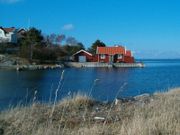
As of April 2007, the total population of Sweden was estimated to be 9,131,425. The population exceeded 9,000,000 for the first time as of approximately 12 August 2004 according to the Statistics Sweden. Of the 2004 population, 1.1 million, or 12%, were foreign-born and approximately 16.7% (1.53 million) had at least one parent born abroad or were themselves born abroad. This reflects the inter-Nordic migrations, earlier periods of labour immigration, and later decades of refugee and family immigration. Sweden has been transformed from a nation of emigration ending after World War I to a nation of immigration from World War II onwards. In 2006, immigration to Sweden reached its highest level since records began.
The largest immigrant group living in Sweden as of 2005 consists of people born in Finland, followed by people born in Iraq, Former Yugoslavia, Germany, Denmark, Norway, Turkey, Poland, Russia and Iran.
Today, Sweden has one of the largest exile communities of Assyrian Christians (also known as Syriacs, Suryoye, Arameans and Chaldeans).
Immigration from the other Nordic countries reached a peak of more than 40,000 per year in 1969-70 when the new immigration rules introduced in 1967 had made it more difficult for immigrants from outside the Nordic region to settle in Sweden for labour market policy reasons. Immigration by refugees and immigrating relatives of refugees from outside the Nordic region increased drastically during the late 1980s, with many of the immigrants arriving from Asia and America, especially from Iran and Chile. During the 1990s and onwards another large immigrant group came from former Yugoslavia and the Middle East.
Language
The primary language of Sweden is Swedish, a North Germanic language, related and very similar to Danish and Norwegian, but differing in pronunciation and orthography. Norwegians have little difficulty understanding Swedish, and Danes can also understand it, with slightly more difficulty than the Norwegians. The dominant language is Swedish, though it is not an official language. However, with the recognition of five minority languages of Sweden ( Finnish, Meänkieli, Sami, Romani and Yiddish) the issue of whether Swedish should be declared the official language was raised. The parliament voted in 2005 but the proposal narrowly failed.
In varying degrees, depending largely on frequency of interaction with English, a majority of Swedes, especially those born after World War II, understand and speak English thanks to trade links, the popularity of overseas travel, a strong Anglo-American influence and the tradition of subtitling rather than dubbing foreign television shows and films. English became a compulsory subject for secondary school students studying natural sciences as early as 1849, and has been a compulsory subject for all Swedish students since the late 1940s. Depending on the local school authorities, English is currently a compulsory subject between first grade and ninth grade, with all students continuing in secondary school studying English for at least another year. Most students also study one and sometimes two additional languages. These include (but are not limited to) German, French and Spanish. Some Danish and Norwegian is at times also taught as part of the Swedish course for native speakers.
Sweden Finns are Sweden's largest linguistic minority. They make around 3 percent of Sweden's population. On the other hand, in neighboring Finland, Swedish is first language for about 5.5 percent (2007) of the population, the so called Swedish-speaking Finns. Swedish-speakers are found in rural and coastal municipalities. Swedish is an official language in these municipalities and holds the status of an official language of the state. There are mandatory Swedish courses in the secondary school.
Religion
Before the eleventh century, Swedes adhered to Norse paganism, worshiping Æsir gods, with its centre at the Temple in Uppsala. With Christianization in the 11th century, the laws of the country were changed, forbidding worship of other deities into the late nineteenth century.
After the Protestant Reformation in the 1530s, a change significantly affected by Martin Luther's Swedish associate Olaus Petri, the Church and state were separated and the authority of Roman Catholic bishops abolished, allowing Lutheranism to prevail. This process was completed by the Uppsala Synod of 1593. During the era following the Reformation, usually known as the period of Lutheran Orthodoxy, small groups of non-Lutherans, especially Calvinist Dutchmen, the Moravian Church and Walloons or French Huguenots from Belgium, played a significant role in trade and industry, and were quietly tolerated as long as they kept a low religious profile. The Sami originally had their own shamanistic religion, but they were converted to Lutheranism by Swedish missionaries in the 17th and 18th centuries.
Not until liberalization in the late 18th century, however, were believers of other faiths, including Judaism and Roman Catholicism, allowed to openly live and work in Sweden, and it remained illegal until 1860 for Lutheran Swedes to convert to another religion. The 19th century saw the arrival of various evangelical free churches, and, towards the end of the century secularism, leading many to distance themselves from Church rituals. Leaving the Church of Sweden became legal with the so-called dissenter law of 1860, but only under the provision of entering another denomination. The right to stand outside any religious denomination was established in the Law on Freedom of Religion in 1951.
Today about 75% of Swedes belong to the Church of Sweden (Lutheran), but the number is decreasing by about 1% every year, and Church of Sweden services are sparsely attended (hovering in the single digit percentages of the population). The reason for the large number of inactive members is partly that until 1996, children became members automatically at birth if at least one of the parents was a member. Since 1996, all children that are christened become members. Some 275,000 Swedes are today members of various free churches (where congregation attendance is much higher), and, in addition, immigration has meant that there are now some 92,000 Roman Catholics and 100,000 Eastern Orthodox Christians living in Sweden. Because of immigration, Sweden also has a significant Muslim population. Almost 500,000 are Muslims by tradition, but approximately 5% (25,000) of these are practising Islam (in the sense of attending Friday prayer and praying five times a day). (See Islam in Sweden.)
According to the most recent Eurobarometer Poll 2005, 23% of Swedish citizens responded that "they believe there is a god", whereas 53% answered that "they believe there is some sort of spirit or life force" and 23% that "they do not believe there is any sort of spirit, god, or life force".
Sweden ranks aside with France and Russia on having a large minority of its citizens who have no religion. Independent of these statistics, it is generally known that Swedish society, collectively, considers religiousness as a private affair separate from daily life.
Health
Healthcare in Sweden is developed. Sweden ranks in the top five countries with respect to low infant mortality. It also ranks high in life expectancy and in safe drinking water. World-class hospitals in Sweden include Lund University, Karolinska University Hospital, Sahlgrenska University Hospital, Linköping University Hospital and Uppsala University Hospital.
A person seeking care first contacts a clinic for a doctor's appointment, and may then be referred to a specialist by the clinic physician, who may in turn recommend either in-patient or out-patient treatment, or an elective care option. The health care is governed by the 21 Landsting ( County councils) of Sweden, which act on general recommendations of the parliament, and delegate local government to the municipalities. Regulations, waiting times and patient fees vary in the different Landsting. The main criticism leveled at Swedish health care is that the waiting times are too long. Another criticism is that waiting times, quality of care and patient fees may vary in different counties, effectively meaning that patients may be treated better depending on where they live.
Culture

Sweden has many authors of worldwide recognition including August Strindberg, Astrid Lindgren, and Nobel Prize winners Selma Lagerlöf and Harry Martinson. In total seven Nobel Prizes in Literature have been awarded to Swedes. The nation's most well-known artists are painters such as Carl Larsson and Anders Zorn, and the sculptors Tobias Sergel and Carl Milles.
Swedish twentieth-century culture is noted by pioneering works in the early days of cinema, with Mauritz Stiller and Victor Sjöström. In the 1920s–1980s, the filmmaker Ingmar Bergman and actors Greta Garbo and Ingrid Bergman became internationally noted people within cinema. More recently, the films of Lukas Moodysson and Lasse Hallström have received international recognition.
Throughout the 1960s and 1970s Sweden was seen as an international leader in what is now referred to as the " sexual revolution", with gender equality having particularly been promoted. At the present time, the number of single people is one of the highest in the world. The early Swedish film I Am Curious (Yellow) (1967) reflected a liberal view of sexuality, including scenes of love making that caught international attention, and introduced the concept of the "Swedish sin". Sweden has also become, in recent decades, fairly liberal regarding homosexuality, as is reflected in the popular acceptance of films such as Show Me Love, which is about two young lesbians in the small Swedish town of Åmål. In the absence of legislation on same-sex marriages, Sweden offers both registered partnerships and domestic partnerships for same-sex couples. Cohabitation (sammanboende) by heterosexual couples of all ages, including teenagers as well as elderly couples, is widespread although in recent years it has become administratively problematical with regard to proof in claims of "spousal" social security. About half the children in the country are born out of wedlock. Presence of already obtained common-law offspring in newspaper photographs of marrying couples is commonplace.
Music
Sweden has a rich musical tradition, ranging from medieval folk ballads to hip hop music. The music of the pre-Christian Norse has been lost to history, although historical re-creations have been attempted based on instruments found in Viking sites. Instruments used were the lur (a sort of trumpet), simple string instruments, wooden flutes and drums. It is possible that the Viking musical legacy lives on in some of the old Swedish folk music.
Sweden has a significant folk-music scene, both in the traditional style as well as more modern interpretations which often mix in elements of rock and jazz. Väsen is more of a traditionalist group, using a unique traditional Swedish instrument called the nyckelharpa while Garmarna, Nordman, and Hedningarna have more modern elements. There is also Saami music, called the joik, which is actually a type of chant which is part of the traditional Saami animistic spirituality but has gained recognition in the international world of folk music as well. Sweden has a major market for new age and ecologically or environmentally aware music, as well a large portion of pop and rock music have liberal and left-wing political messages.
Sweden also has a prominent choral music tradition, deriving in part from the cultural importance of Swedish folk songs. In fact, out of a population of 9.1 million, it is estimated that five to six hundred thousand people sing in choirs.
ABBA was one of the first internationally well-known popular music bands from Sweden, and still ranks among the most prominent bands in the world, with about 370 million records sold. With ABBA, Sweden entered into a new era, in which Swedish pop music gained international prominence. There have been many other internationally successful bands since, such as Roxette, Ace of Base, and the Cardigans to name some of the biggest, and recently there has been a surge of Swedish Indie pop bands such as Peter, Bjorn & John, The Hives and Mando Diao. Sweden has also become known for a large number of heavy metal (mostly death metal and melodic death metal ) as well as progressive- and power metal bands.
Sweden is the 3rd largest music exporter in the world, with over 800 million dollars in revenue last year, surpassed only by the US and the UK.
Sweden has a rather lively jazz scene. During the last sixty years or so it has attained a remarkably high artistic standard, stimulated by domestic as well as external influences and experiences. The Centre for Swedish Folk Music and Jazz Research has published an overview of jazz in Sweden by Lars Westin.
Literature
The first literary text from Sweden is the Rök Runestone, carved during the Viking Age circa 800 AD. With the conversion of the land to Christianity around 1100 AD, Sweden entered the Middle Ages, during which monastic writers preferred to use Latin. Therefore there are only a few texts in the Old Swedish from that period. Swedish literature only flourished when the Swedish language was standardized in the 16th century, a standardization largely due to the full translation of the Bible into Swedish in 1541. This translation is the so-called Gustav Vasa Bible.
With improved education and the freedom brought by secularisation, the 17th century saw several notable authors develop the Swedish language further. Some key figures include Georg Stiernhielm (17th century), who was the first to write classical poetry in Swedish; Johan Henric Kellgren (18th century), the first to write fluent Swedish prose; Carl Michael Bellman (late 18th century), the first writer of burlesque ballads; and August Strindberg (late 19th century), a socio-realistic writer and playwright who won worldwide fame. The early 20th century continued to produce notable authors, such as Selma Lagerlöf, ( Nobel laureate 1909), Verner von Heidenstam (Nobel laureate 1916) and Pär Lagerkvist (Nobel laureate 1951).
In recent decades, a handful of Swedish writers have established themselves internationally, including the detective novelist Henning Mankell and the writer of spy fiction Jan Guillou. But the only Swedish writer to have made a significant mark on world literature is the children's book writer Astrid Lindgren, and her books about Pippi Longstocking, Emil of Maple Hills, and others.
Inventions
In the 18th century Sweden's scientific revolution took off. Previously, technical progress had mainly come from professionals who had immigrated from mainland Europe. In 1739, the Royal Swedish Academy of Sciences was founded, with people such as Carolus Linnaeus and Anders Celsius as early members. From the 1870s, engineering companies were created at an unmatched rate and engineers became heroes of the age. Many of the companies founded by early pioneers are still internationally familiar. Gustaf Dalén founded AGA, and received the Nobel Prize for his sun valve. Alfred Nobel invented dynamite and instituted the Nobel Prizes. Lars Magnus Ericsson started the company bearing his name, Ericsson, still one of the largest telecom companies in the world. Jonas Wenström was an early pioneer in alternating current and is along with Serbian inventor Tesla credited as one of the inventors of the three-phase electrical system.
The traditional engineering industry is still a major source of Swedish inventions, but pharmaceuticals, electronics and other high-tech industries are gaining ground. Tetra Pak is an invention for storing liquid foods, invented by Erik Wallenberg. Håkan Lans invented the Automatic Identification System, a worldwide standard for shipping and civil aviation navigation. Losec, an ulcer medicine, was the world's best-selling drug in the 1990s and was developed by AstraZeneca. A large portion of the Swedish economy is to this day based on the export of technical inventions, and many large multinational corporations from Sweden have their origins in the ingenuity of Swedish inventors.
Holidays
Apart from traditional Protestant Christian holidays, Sweden also celebrates some unique holidays, some of a pre-Christian tradition. They include Midsummer celebrating the summer solstice; Walpurgis Night (Valborgsmässoafton) on 30 April lighting bonfires; and Labour Day or Mayday on 1 May is dedicated to socialist demonstrations. The day of giver-of-light Saint Lucia, 13 December, is widely acknowledged in elaborate celebrations which betoken its Italian origin and commence the month-long Christmas season. 6 June is the National Day of Sweden and, as of 2005, a public holiday. Furthermore, there are official flag day observances and a Namesdays in Sweden calendar. In August many Swedes have kräftskivor (crayfish dinner parties). Martin of Tours Eve is celebrated in Scania in November with Mårten Gås parties, where roast goose and svartsoppa ('black soup', made of goose stock, fruit, spices, spirits and goose blood) are served. The Sami, one of Sweden's indigenous minorities, have their holiday on February 6 and Scania celebrate their Scanian Flag day on the third Sunday in July.
Cuisine
Swedish cuisine, like that of the other Scandinavian countries ( Denmark and Norway), was traditionally simple. Fish (particularly herring), meat and potatoes played prominent roles. Spices were sparse. Famous dishes include Swedish meatballs, traditionally served with gravy, boiled potatoes and lingonberry jam; pancakes, lutfisk, and Smörgåsbord, or lavish buffet. Akvavit is a popular alcoholic distilled beverage, and the drinking of snaps is of cultural importance. The traditional flat and dry crisp bread has developed into several contemporary variants. Regionally important foods are the surströmming (a fermented fish) in Northern Sweden and eel in Scania in Southern Sweden. However, Swedes have traditionally also been very open to foreign influences, ranging from the French cuisine during the eighteenth century, to the sushi and cafe latte of today.
Film
Swedes have been fairly prominent in the film area through the years, to several successful Swedish Hollywood actors can be mentioned: Ingrid Bergman, Greta Garbo, Max von Sydow, Dolph Lundgren, Lena Olin, Stellan Skarsgård, Peter Stormare, Izabella Scorupco, Pernilla August, Ann Margaret, Anita Ekberg, Alexander Skarsgård, Harriet Andersson, Bibi Andersson, Ingrid Thulin and Gunnar Björnstrand. Amongst several directors who have made internationally successful films can be mentioned: Ingmar Bergman and Lasse Hallström.
Comics
Compared to countries like France and Belgium, the Swedish production of comics have been relatively scarce. Back in the 40s, the Biffen och Bananen strips ("The Beef and the Banana") were very popular. Some modern popular humor comic strips are Herman Hedning, about an aggressive and impulsive caveman, and Hälge, about a moose in a small town, and his problems with mating and the moose hunt. Around the 60's-70's, the children's comic Bamse, about an anthropomorph bear and his adventures slowly grew in popularity, having been read by generations of Swedish children. Starting somewhere in the 80's, comics more directly aimed at adults started to become popular. Some of the more popular examples stemming from this tradition are Arne Anka, about a cynical duck discussing politics or unsuccessfully attempts picking up women at Stockholm's bars, Rocky, a mostly autobiographical comic about a cartoonist dog drifting around in Stockholm, and Elvis, about a turtle and his relationship problems. Among imported comics, popular examples include Donald Duck, Tintin, Beetle Bailey and Piranha Club. Since the 40's-50's, The Phantom has been popular, and since the 60's, the Scandinavian Team Fantomen has produced comics directly for the Scandinavian market. Recently, starting somewhere around the late 90's, manga (Japanese comics) has become very popular.
Fashion
Sweden has in late years taken an interest in the fashion industry, through headquartering famous brands like Hennes & Mauritz (operating as H&M), J. Lindeberg (operating as JL), Gina Tricot, Tiger of Sweden and Filippa K within its borders. These companies, however, are comprised largely of buyers who import fashionable goods from throughout Europe and the Americas, continuing the trend of Swedish business toward multinational economic dependency like many of its neighbours.
Sports
Sport activities are a national movement with half of the population actively participating, much thanks to the heavy government subsidies of sport associations (föreningsstöd). The two main spectator sports are association football and ice hockey. Second to football, horse sports have the highest number of practitioners, mostly women. Thereafter follow golf, athletics, and the team sports of handball, floorball, basketball and bandy.
The Swedish ice hockey team Tre Kronor is regarded as one of the best in the world and has won the World Championships seven times, and Olympic gold medals in 1994 and 2006. In 2006, as the first nation in history, they won both the Olympic and world championships in the same year. The Swedish national football team has seen some success at the World Cup in the past, finishing second when they hosted the tournament in 1958, and third twice, in 1950 and 1994. Athletics has enjoyed a surge in popularity due to several successful athletes in recent years.
In schools, on meadows and in parks, the game brännboll, a sport similar to baseball, is commonly played for fun. Other leisure sports are the historical game of kubb, and boules among the older generation.
Sweden hosted the 1912 Summer Olympics and the FIFA World Cup in 1958. Other big sports events held here include 1992 UEFA European Football Championship, FIFA Women's World Cup 1995, and several championships of ice hockey, curling, athletics, skiing, bandy, figure skating and swimming.
International rankings
| Name | Year | Place | Out of # | Reference |
|---|---|---|---|---|
| CIA World Factbook – GDP per capita ( PPP) | 2008 | 26th | 229 | |
| CIA World Factbook – life expectancy | 2008 | 9th | 223 | |
| World Economic Forum – Enabling Trade Index ranking | 2008 | 3rd | 118 | |
| Yale University / Columbia University - Environmental Performance Index | 2008 | 3rd | 149 | |
| The Economist Intelligence Unit - e-readiness | 2008 | 3rd | 70 | |
| The Economist Intelligence Unit - Global Peace Index | 2008 | 13th | 140 | |
| Save the Children - Mother's Index Rank | 2007 | 1st | 141 | |
| Save the Children - Women's Index Rank | 2007 | 1st | 141 | |
| Save the Children - Children's Index Rank | 2007 | 4th | 141 | |
| Wall Street Journal / The Heritage Foundation - Index of Economic Freedom | 2007 | 27th | 157 | |
| United Nations - Human Development Index | 2007 | 6th | 177 | |
| World Economic Forum - Global Competitiveness Report 2007-2008 | 2007 | 4th | 131 | |
| World Economic Forum - The Global Gender Gap Report 2007 | 2007 | 1st | 128 | |
| World Bank - Ease of Doing Business Index | 2007 | 14th | 178 | |
| Reporters Without Borders - Worldwide Press Freedom Index | 2007 | 5th | 169 | |
| Transparency International - Corruption Perceptions Index | 2007 | 4th | 179 | |
| The Economist Intelligence Unit - Index of Democracy | 2007 | 1st | 167 | |
| Privacy International - Privacy index (EU and 11 other selected countries) | 2006 | 28th | 36 | |
| New Economics Foundation - Happy Planet Index | 2006 | 119th | 178 | |
| The Economist Intelligence Unit - Quality-of-life index | 2005 | 5th | 111 | |
| Save the Children - % seats in the national government held by women | 2004 | 1st (47%) | 141 | |
| World Health Organization - suicide rates by country | 31st | 100 | ||
| NationMaster's index of civil and political liberties | 13th | 140 | ||
| NationMaster's index of asylum seekers (per capita) | 4th | 28 | ||
| NationMaster's index of economic aid (donor, per capita) | 5th | 24 | ||
| NationMaster's index of total tax wedge (single worker) | 4th | 29 | ||
| NationMaster's index of technological achievement | 3rd | 68 |


